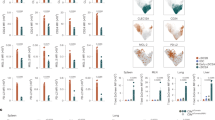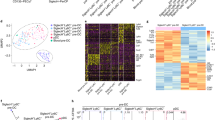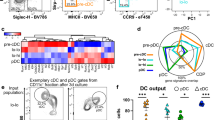Abstract
The origin and specification of human dendritic cells (DCs) have not been investigated at the clonal level. Through the use of clonal assays, combined with statistical computation, to quantify the yield of granulocytes, monocytes, lymphocytes and three subsets of DCs from single human CD34+ progenitor cells, we found that specification to the DC lineage occurred in parallel with specification of hematopoietic stem cells (HSCs) to the myeloid and lymphoid lineages. This started as a lineage bias defined by specific transcriptional programs that correlated with the combinatorial 'dose' of the transcription factors IRF8 and PU.1, which was transmitted to most progeny cells and was reinforced by upregulation of IRF8 expression driven by the hematopoietic cytokine FLT3L during cell division. We propose a model in which specification to the DC lineage is driven by parallel and inheritable transcriptional programs in HSCs and is reinforced over cell division by recursive interactions between transcriptional programs and extrinsic signals.
This is a preview of subscription content, access via your institution
Access options
Access Nature and 54 other Nature Portfolio journals
Get Nature+, our best-value online-access subscription
$29.99 / 30 days
cancel any time
Subscribe to this journal
Receive 12 print issues and online access
$209.00 per year
only $17.42 per issue
Buy this article
- Purchase on Springer Link
- Instant access to full article PDF
Prices may be subject to local taxes which are calculated during checkout







Similar content being viewed by others
Change history
05 July 2017
In the version of this article initially published online, the flow cytometric dots were missing in the middle plot of the leftmost column in Figure 2f. The error has been corrected in the print, PDF and HTML versions of this article.
References
Manz, M.G., Traver, D., Miyamoto, T., Weissman, I.L. & Akashi, K. Dendritic cell potentials of early lymphoid and myeloid progenitors. Blood 97, 3333–3341 (2001).
D'Amico, A. & Wu, L. The early progenitors of mouse dendritic cells and plasmacytoid predendritic cells are within the bone marrow hemopoietic precursors expressing Flt3. J. Exp. Med. 198, 293–303 (2003).
Karsunky, H., Merad, M., Cozzio, A., Weissman, I.L. & Manz, M.G. Flt3 ligand regulates dendritic cell development from Flt3+ lymphoid and myeloid-committed progenitors to Flt3+ dendritic cells in vivo. J. Exp. Med. 198, 305–313 (2003).
Geissmann, F. et al. Development of monocytes, macrophages, and dendritic cells. Science 327, 656–661 (2010).
Akashi, K., Traver, D., Miyamoto, T. & Weissman, I.L. A clonogenic common myeloid progenitor that gives rise to all myeloid lineages. Nature 404, 193–197 (2000).
Adolfsson, J. et al. Identification of Flt3+ lympho-myeloid stem cells lacking erythro-megakaryocytic potential a revised road map for adult blood lineage commitment. Cell 121, 295–306 (2005).
Lee, J. et al. Restricted dendritic cell and monocyte progenitors in human cord blood and bone marrow. J. Exp. Med. 212, 385–399 (2015).
Schlitzer, A. et al. Identification of cDC1- and cDC2-committed DC progenitors reveals early lineage priming at the common DC progenitor stage in the bone marrow. Nat. Immunol. 16, 718–728 (2015).
Grajales-Reyes, G.E. et al. Batf3 maintains autoactivation of Irf8 for commitment of a CD8α+ conventional DC clonogenic progenitor. Nat. Immunol. 16, 708–717 (2015).
Mercier, F.E. & Scadden, D.T. Not all created equal: lineage hard-wiring in the production of blood. Cell 163, 1568–1570 (2015).
Naik, S.H. et al. Diverse and heritable lineage imprinting of early haematopoietic progenitors. Nature 496, 229–232 (2013).
Perié, L., Duffy, K.R., Kok, L., de Boer, R.J. & Schumacher, T.N. The branching point in erythro-myeloid differentiation. Cell 163, 1655–1662 (2015).
Paul, F. et al. Transcriptional heterogeneity and lineage commitment in myeloid progenitors. Cell 163, 1663–1677 (2015).
Yamamoto, R. et al. Clonal analysis unveils self-renewing lineage-restricted progenitors generated directly from hematopoietic stem cells. Cell 154, 1112–1126 (2013).
Sun, J. et al. Clonal dynamics of native haematopoiesis. Nature 514, 322–327 (2014).
Becker, A.M. et al. IRF-8 extinguishes neutrophil production and promotes dendritic cell lineage commitment in both myeloid and lymphoid mouse progenitors. Blood 119, 2003–2012 (2012).
Schönheit, J. et al. PU.1 level-directed chromatin structure remodeling at the Irf8 gene drives dendritic cell commitment. Cell Rep. 3, 1617–1628 (2013).
Manz, M.G., Miyamoto, T., Akashi, K. & Weissman, I.L. Prospective isolation of human clonogenic common myeloid progenitors. Proc. Natl. Acad. Sci. USA 99, 11872–11877 (2002).
Doulatov, S. et al. Revised map of the human progenitor hierarchy shows the origin of macrophages and dendritic cells in early lymphoid development. Nat. Immunol. 11, 585–593 (2010).
Goardon, N. et al. Coexistence of LMPP-like and GMP-like leukemia stem cells in acute myeloid leukemia. Cancer Cell 19, 138–152 (2011).
Breton, G. et al. Circulating precursors of human CD1c+ and CD141+ dendritic cells. J. Exp. Med. 212, 401–413 (2015).
Notta, F. et al. Distinct routes of lineage development reshape the human blood hierarchy across ontogeny. Science 351, aab2116 (2015).
Moignard, V. et al. Decoding the regulatory network of early blood development from single-cell gene expression measurements. Nat. Biotechnol. 33, 269–276 (2015).
Van Der Maaten, L. Accelerating t-sne using tree-based algorithms. J. Mach. Learn. Res. 15, 3221–3245 (2014).
Aliberti, J. et al. Essential role for ICSBP in the in vivo development of murine CD8α+ dendritic cells. Blood 101, 305–310 (2003).
Carotta, S. et al. The transcription factor PU.1 controls dendritic cell development and Flt3 cytokine receptor expression in a dose-dependent manner. Immunity 32, 628–641 (2010).
Hambleton, S. et al. IRF8 mutations and human dendritic-cell immunodeficiency. N. Engl. J. Med. 365, 127–138 (2011).
Kurotaki, D. et al. IRF8 inhibits C/EBPα activity to restrain mononuclear phagocyte progenitors from differentiating into neutrophils. Nat. Commun. 5, 4978 (2014).
Wang, H. et al. A reporter mouse reveals lineage-specific and heterogeneous expression of IRF8 during lymphoid and myeloid cell differentiation. J. Immunol. 193, 1766–1777 (2014).
Naik, S.H. et al. Cutting edge: generation of splenic CD8+ and CD8− dendritic cell equivalents in Fms-like tyrosine kinase 3 ligand bone marrow cultures. J. Immunol. 174, 6592–6597 (2005).
Carotta, S. et al. The transcription factors IRF8 and PU.1 negatively regulate plasma cell differentiation. J. Exp. Med. 211, 2169–2181 (2014).
Belz, G.T. & Nutt, S.L. Transcriptional programming of the dendritic cell network. Nat. Rev. Immunol. 12, 101–113 (2012).
Collin, M., Bigley, V., Haniffa, M. & Hambleton, S. Human dendritic cell deficiency: the missing ID? Nat. Rev. Immunol. 11, 575–583 (2011).
Tussiwand, R. et al. Compensatory dendritic cell development mediated by BATF-IRF interactions. Nature 490, 502–507 (2012).
Glasmacher, E. et al. A genomic regulatory element that directs assembly and function of immune-specific AP-1-IRF complexes. Science 338, 975–980 (2012).
Grajkowska, L.T. et al. Isoform-specific expression and feedback regulation of E protein TCF4 control dendritic cell lineage specification. Immunity 46, 65–77 (2017).
Schmid, M.A., Kingston, D., Boddupalli, S. & Manz, M.G. Instructive cytokine signals in dendritic cell lineage commitment. Immunol. Rev. 234, 32–44 (2010).
Rahman, N. A Course in Theoretical Statistics (Charles Griffin and Company, 1968).
Anders, S. & Huber, W. Differential expression analysis for sequence count data. Genome Biol. 11, R106 (2010).
Acknowledgements
We thank S. Goff, S. Reiner and R. Belsky for discussions. Supported by the Empire State Stem Cell Fund through the New York State Department of Health (C029562 to K.L.) and The US National Institute of Health (AI101251 to K.L.). Research reported in this manuscript was performed partly by the Columbia Center for Translational Immunology Flow Cytometry Core, supported in part by the Office of the Director of the US National Institutes of Health (S10RR027050 and S10OD020056).
Author information
Authors and Affiliations
Contributions
J.L., Y.J.Z. and K. Liu designed the study; J.L., Y.J.Z., A.A., K. Lucero and D.L. performed the experiments; J.L., Y.J.Z., D.L. and K. Liu performed data analysis; W.M., W.Z., T.L. and Y.S. did the statistical computation and modeling; M.T. and G.B. provided human samples; and J.L., Y.J.Z., W.M., Y.S. and K. Liu wrote the manuscript.
Corresponding authors
Ethics declarations
Competing interests
The authors declare no competing financial interests.
Integrated supplementary information
Supplementary Figure 1 Colony-forming unit (CFU) assay and culture on MP and FSG reveal developmental convergence for different marker-pure progenitor cells isolated from cord blood.
(a) Stacked columns showing colony-forming units (CFU) produced by indicated populations after culturing in methylcellulose for 14 days. M, macrophage; G, granulocyte; GM, granulocyte and macrophage; GEMM, granulocyte, erythrocyte, megakaryocyte and macrophage; E, erythrocyte. Bars, mean averages; error bars, SEM. (b) Flow cytometry plots (top) showing the gating strategy to identify downstream progenitors from HSC/MPPs after culturing in MP+FSG for 6 days. Colored frames (bottom) showing the populations that have been concatenated in order to plot Fig. 1c and their respective degree of cell division as indicated by CFSE. (c, d) Representative flow cytometry plots showing all downstream populations produced by the input progenitor after (c) in vitro culture or (d) in vivo transfer. Plots in c are the original gating strategy for Fig. 1d. Numbers indicate percentages from parental gate. (e) Schematic picture summarizing the developmental relationship of CD34+ progenitors. Data shown are representative of four (a), four (b-c), and three (d) independent experiments.
Supplementary Figure 2 Clonal output of single cord-blood progenitor cells reveals lineage heterogeneity among marker-pure progenitor populations.
(a) Scatter plots showing the number of cells produced for each lineage from all clones of each indicated progenitor type. (b) Heat maps showing normalized output of mature cells of each type (row) from each single cell (column) in indicated progenitor populations. (c) Plots showing distribution of single progenitor cells (columns) from individual donors (rows) within the four clusters (top) identified by unsupervised hierarchical clustering (Euclidean distance and complete linkage) based on the clonal outcome, as shown in Fig. 2g. Data represent cumulative clones from seventeen cord blood donors (a-c).
Supplementary Figure 3 t-SNE analysis and visualization of quantitative clonal data resembles principal-component analysis results.
(a) Flow cytometry plots showing HSC-derived cells sorted from division 0, 3 and 6 (boxes) for clonal analysis in either MP+FSG culture (left) or in NSG mice (right) as described in Fig. 3a. (b, c) PCA analysis (upper panels) or t-SNE analysis (lower panels) visualizing clonal output data from 2,247 individual progenitor cells, with color labeling according to (b) the number of cells produced or (c) the degree of commitment toward the stated cell lineage (top labels). (d) t-SNE plots showing consistent clustering results of total clonal data from three different runs. Perplexity and theta are parameters of t-SNE, and Rand index is a measure of the similarity. Data represent cumulative clones from seventeen cord blood donors (a-d).
Supplementary Figure 4 HSC-MPPs show lineage bias in a permissive culture system that supports eight lineages.
(a-b) Flow cytometry plot showing lineage output of representative HSC/MPP clones in a culture system described by John Dick’s group (Notta et al. Science 2016), referred to here as JD culture. Data represent concatenated (a) and individual (b) clones. The following eight lineages are highlighted in gates with different colors: erythrocyte (Er), megakaryocyte (Mk), granulocyte (G), monocyte (M), CD1c cDCs (DC2), CD141 cDCs (DC1), and B/NK cells (L). (c) Line plot showing totipotent HSC/MPP clones in JD (top) and MP+FSG culture (bottom). Clones were plotted according to the yield of each lineage, where each line is an individual clone. (d) Scatter plot comparing the yield of all progenies from totipotent or non-totipotent HSC/MPP clones in JD culture (top) and MP+FSG culture (bottom). (e-f) Frequency distribution of all non-unipotent clones, based on their degree of equipotency (e) and bias (f) from JD culture (top) and MP+FSG culture (bottom). Numbers indicate the cumulative % of clones for which the ratio is <0.5 (left line) or >0.5 (right line). Red bars indicate totipotent HSC/MPP clones; black bars indicate non-totipotent HSC/MPP clones. Data shown are representative of three independent experiments (for JD culture), or cumulative clones from seventeen cord blood donors (for MP+FSG culture). * p <0.05; **** p <0.0001 (unpaired two-tailed Student’s t-test).
Supplementary Figure 5 Lineage switching by HSC-MPP-derived granddaughter cells is more flexible than that of those from GMDPs.
(a) Fluorescence microscopy images showing DiD-labeled single ancestor cell and four granddaughter cells after 2–4 days of culture in MP+FSG condition. Scale bar: 100μm (b) Each t-SNE plot showing the developmental position of the ancestral clone (black) and progeny that have either inherited (red) or switched (blue) lineage bias. (c) Dot plots summarizing the distance of all progeny of HSCs and GMDPs, including bias-inherited (red) and bias-switched (blue) progeny, to its ancestral track. (d) t-SNE maps showing distribution of clones from each marker-pure population. Color indicates multipotency or unipotency. Data shown are representative of three independent experiments (a-c), or cumulative clones from seventeen cord blood donors (d).
Supplementary Figure 6 Heritable lineage bias model.
(a) A limited transcription factor set and environmental signals (Ex) are potentially sufficient to initiate L (B/NK), pDC, DC1 (CD141+ DC), DC2 (CD1c+ DC), M (Monocyte) and G (Granulocyte) lineages that can be memorized and reinforced over division through dose-dependent function and the process of recursive interaction described in b. (b) Graphic representation of feedback cycle of CD141 DC lineage commitment. Transcriptional programs established in HSCs by different dosage combinations of common transcription factors (TFs) including PU.1 and IRF8 (TF1) cause initial expression of cell surface receptors (R1), which can in turn bind extrinsic signals (Ex1). These signals drive cell division but also orchestrate intracellular signals that give rise to a modified intrinsic transcriptional program (TF2) and expression of new receptors (R2) that can integrate additional extrinsic signals (Ex2). The recursive interaction between intrinsic and extrinsic signals over each cycle enables progenitors to “memorize” the preferential lineage identity conferred by the initial transcriptional program at the HSC stage, and to strengthen that lineage identity through expression of TFs like BATF3, which is required for terminal commitment.
Supplementary information
Supplementary Text and Figures
Supplementary Figures 1–6 and Supplementary Table 1 (PDF 3684 kb)
Rights and permissions
About this article
Cite this article
Lee, J., Zhou, Y., Ma, W. et al. Lineage specification of human dendritic cells is marked by IRF8 expression in hematopoietic stem cells and multipotent progenitors. Nat Immunol 18, 877–888 (2017). https://doi.org/10.1038/ni.3789
Received:
Accepted:
Published:
Issue Date:
DOI: https://doi.org/10.1038/ni.3789
This article is cited by
-
Intrathymic dendritic cell-biased precursors promote human T cell lineage specification through IRF8-driven transmembrane TNF
Nature Immunology (2023)
-
CD66b−CD64dimCD115− cells in the human bone marrow represent neutrophil-committed progenitors
Nature Immunology (2022)
-
Compromised anti-tumor–immune features of myeloid cell components in chronic myeloid leukemia patients
Scientific Reports (2021)
-
A RUNX–CBFβ-driven enhancer directs the Irf8 dose-dependent lineage choice between DCs and monocytes
Nature Immunology (2021)
-
Genetic models of human and mouse dendritic cell development and function
Nature Reviews Immunology (2021)



